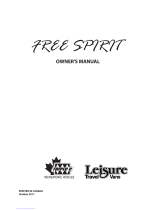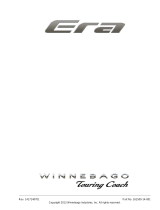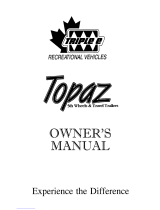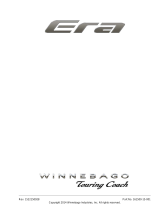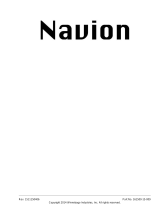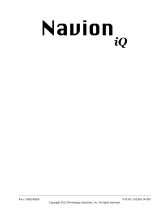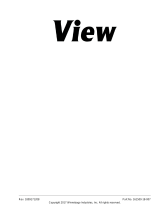
Owner’s Manual


Serenity MotorhomeContents
Table of Contents
Introduction 1
Owner’s Manual 1
Motorhome Information Kit 2
Options and Equipment 2
Vehicle Certication Labels 3
Reference Number Codes 3
Certication Label Samples 4
Serenity Floor Plans 5
Service Assistance 8
Reporting Safety Defects 8
Coach Specications 8
Safety 9
General Safety 9
Alarms 10
Combination Carbon Monoxide / LP Gas Alarm 10
Fuel and Propane Safety 10
Carbon Monoxide Alarm 11
Smoke Alarm 12
Fire Prevention 13
Fire Safety Tips 13
Fire Extinguisher 13
Emergency Escape - Egress Window 14
Vehicle Operations 15
Vehicle Preparation 15
Keys 15
Vehicle Loading and Weights 15
Tow i n g 16
Auxiliary Vehicle Towing 16
Pre-Trip Inspection 17
Emergency Equipment Checklist 18
Final Checks 18
Maximum Occupancy 18
Seat / Shoulder Belts 19
Driver / Passenger Seat Controls 20
Travelling 22
Driving Characteristics 22
Driving Safety Tips 23
Travel Tips 23
Severe Weather Information 24
Emergencies While Driving 24
Hazard Warning Lights 24
Flat Tire 25
When the Vehicle is Disabled 25
Overheating 26
Parking 26
Extended Occupancy 27
Levelling the Motorhome 28
Stabilizers 28
Refuelling the Vehicle Chassis 29
Door Locks 30
Entry Door Step 31
Door Strut 31
Cab Entry Light 32
Step Override Switch 33
Exterior/Interior Light Switches 33
Interior Overhead Light Dimmer Switch 33
Under Cabinet Lights 33
Awning 34
Appliance and Equipment Operation 36
Refrigerator 36
Refrigerator Operating Tips 37
Exterior Refrigerator Compartment 37
Stove Top 37
Microwave/Convection Oven 38
Exterior BBQ Connection 38
LP Gas Furnace 39
Roof Air Conditioner with Heat Pump 40
Heat Pump 40
Coach Power Roof Vent 41
Bathroom Roof Vent 42
Side Window Vents 42
Manual Roof Vent 43
Operating the TV 44
TV Utility Panel 45
External Cable TV Connection 46
External Satellite TV Connection 46
TV Antenna 46
Entertainment System Schematics 47
Satellite Pre-Wire Schematic 48

Serenity MotorhomeContents
Forward Bed 49
Electric Rear Sofa (Optional) 50
Electrical System Operation 51
Electrical Supply 51
Serenity Wiring Schematics 52
System Monitor 53
Electrical System Components 54
Power Distribution Panel 55
120 Volt AC Circuit Breakers 55
12 Volt DC Coach Fuses 56
12 Volt DC Chassis Fuses 56
Ground Fault Circuit Interrupter (GFCI) 56
Auxiliary LP Gas Generator (Optional) 57
Auxiliary Diesel Generator (Optional) 58
Generator Safety 59
Automatic Power Transfer Switch 59
12 Volt DC system 60
Chassis Battery 60
Coach Batteries (12 Volt DC Power Supply) 61
Coach Battery Condition Meter 61
Battery Maintenance 61
Inverter 63
Inverter Remote Control Panel 64
Electrical Management System EMS-LCHW30 65
Solar Power Unit 67
Lighting Maintenance 68
Water and Plumbing System 72
Water Supply 72
Fresh Water System 72
External Water Supply 72
Filling the Fresh Water Tank 73
Water Pump Switch 74
Water Pump 75
Fresh Water Tank and Water System Drain 75
Water Pump Initial Startup 76
Water Pump Troubleshooting 76
Water Filter 77
Disinfecting the Water Tank 77
Waste Systems 78
Grey Water - Waste Holding Tank 78
Black Water - Waste Holding Tank 78
Dumping Holding Tanks 78
Black Water Waste Tank Rinse 79
Macerator 80
Holding Tank - Do’s and Don‘ts 80
Using On-Site Sewer Hook-Ups 81
Water Heater 82
TRUMA AQUA-GO® 83
Water Fixtures 84
Fresh Water Toilet 84
Liquid Propane Gas System 86
LP Gas Control Valve (Utility Center) 86
Safe Use Of LP Gas 86
Selecting Fuel Types 87
How LP Gas Works 87
LP Gas Tank System 87
Relling LP Gas Tank 87
Air in the LP Gas Tank 88
Travelling with LP Gas 89
LP Gas Tank Regulator 89
LP Gas Leaks 89
Avoiding Asphyxiation 90
Motorhome Maintenance 91
Exterior Care and Maintenance 91
Interior Care 92
Storage and Winterization 94
Storage Checklist 94
Cold Temperature Storage 95
Water System Winterization 96
De-Winterizing the Water Systems 97
Spring Startup 97
Cold Temperature Operation 97
Chassis 97
LP Gas 97
Waste System 97
Maintenance and Service 98
New Vehicle Limited Warranty 100

Serenity Motorhome
1
Introduction
Introduction
Congratulations! Thank you for selecting a
Leisure Travel Vans Motorhome.
Welcome to the exciting world of motorhome
travel and camping, with all the comforts of
home with you, while you travel and enjoy the
outdoors.
Your motorhome has been designed and
manufactured to enhance your travel and
camping experience, and to provide you with
safe, efcient and trouble-free operation.
Before your rst drive, become familiar with
the operation of the vehicle chassis and all
functions and operations of the motorhome.
Spend adequate time with your dealer when
you take delivery to learn all you can about your
new motorhome.
Owner’s Manual
This manual was prepared to aid the operator
in the operation and care of the motorhome.
There are many options to Leisure Travel
Vans, so ensure that you are familiar with
your motorhome’s systems and equipment.
All operators and occupants of the motorhome
should read, understand and follow the
instructions in this manual, the vehicle chassis
manual & the information contained in the
Motorhome Information Kit provided with your
new motorhome.
Your motorhome contains a number of systems,
components, equipment and appliances
manufactured by vendors that supply
components for Leisure Travel Vans. These
vendors are unrelated to Triple E Canada Ltd.
Before operating the motorhome for the rst
time – even if an experienced motorhome
operator – read and become familiar with all
of the relevant manuals to your motorhome,
components, equipment and appliances
provided in the Motorhome Information Kit. Your
familiarity with the detailed operation of your
motorhome will assist in your safe, efcient and
trouble free motorhome operation.
KEEP the Motorhome Information Kit within
your motorhome for readily available reference.
PASS this Operator’s Manual, the Chassis
Operation Manual and the Motorhome
Information Kit to any subsequent operator or
owner.
For clarication or further details on any of the
enclosed information, please contact:
Your Leisure Travel Vans Dealer or Triple E RV
Customer Service at:
Email: info@tripleerv.com
Toll Free: 877-992-9906
Telephone: 204-325-4361
Fax: 204-325-5241

Serenity Motorhome
2
Motorhome Information Kit
The information kit includes but isn’t limited
to information on the following components,
equipment and appliances listed below.
Introduction
Refrigerator
Stove top
Furnace
Electrical Panel
Toilet
Water Heater
Water Pump
Water Filtration
Vent (roof)
Fire Extinguisher
Smoke Detector
Thermostat
CO Detector
Propane Detector
Gas Regulator
TV Antenna
TV/DVD
Chassis
Air Conditioner
Generator
Stabilizers
Rearview Monitor
Inverter
Entertainment System
Safety
Flooring and Countertops
Electric Step
Solar Panel
Surge Protector
Safe
Options and Equipment
Triple E Recreational Vehicles are available in
various sizes and oor plan congurations and
differing optional equipment. The equipment,
accessories and components described in this
manual may not apply in all respects to your
motorhome. Read the material and manuals
provided in the motorhome Information Kit for
detailed instructions regarding the equipment
specic to your Motorhome.

Serenity Motorhome
3
Introduction
Vehicle Certication Labels
The vehicle certication labels contain vehicle
identication and other important reference
information. Never remove or destroy these
labels. The labels are located on the driver &
passenger door frames. See location details on
the following page.
eference Number Codes
1. anufacture/Conversion ate
The date on which the coach portion of your
Motorhome was built.
2. Gross Vehicle eight ating GV
The maximum permissible weight of this
fully loaded Motorhome.
3. Sleeping Capacity eight ating SC
The manufacturer’s designated number of
sleeping positions multiplied by 154 lbs (70
Kgs).
4. Occupant and Cargo Carrying Capacity
OCCC
The value equal to the GVWR minus UVW
and LP. In other words, OCCC is how much
weight in occupants, cargo, water and trailer
tongue weight that can be added to the
Motorhome without exceeding the GVWR.
5. Gross Combined eight ating GC
The Gross Combined Weights Rating of
the Motorhome, i.e, combined weight of the
Motorhome and any towed vehicle.
6. esignated Sleeping Capacity
The manufacturer’s designated number of
sleeping positions multiplied by 154 lbs (70
Kgs).
7. Gross Ale eight ating GA
The value specied as the load carrying
capacity of a single axle system, as
measured at the tire-ground interface.
8. ire Specication
Recommended tires specication to meet
handling, loading and safety requirements.
Replacement tires must meet these
specications.
9. Cold ire nation Pressure
Ination pressures recommended (while
cold) for the tires originally installed on your
Motorhome. These tire pressure levels must
be maintained to ensure proper handling,
safety and fuel economy.
10. Cargo Carrying Capacity CCC Canada
Equal to GVWR minus each of the following:
UVW, full fresh (potable) water weight
(including water heater), full LP-Gas weight
and SCWR.
11. Unloaded Vehicle eight UV
The weight of this Motorhome as
manufactured at the factory with full fuel,
engine oil and coolants.
12. ass of aste ater ans
Total weight of the black and grey water
tanks when lled to capacity.
13. Vehicle dentication Number VN
This number Identies the chassis on which
the Motorhome is built.
14. ype
States the National Highway Trafc Safety
Association (NHTSA) designated usage
classication for your Motorhome. MPV
signies a Multi-purpose vehicle.

Serenity Motorhome
4
Introduction
Certication Label Samples
Located in Wardrobe
Located in wardrobe closet (Canada models
only)
Located in wardrobe closet (all models)
Located on driver-side door frame (all models)
Located on driver-side door frame (US
models only)
Located on passenger-side door frame
(US models only)
Located on driver-side door frame
(Canada models only)

Serenity Motorhome
5
Introduction
Serenity loor Plans
S4C Passenger Side View
Diesel Fill
Shore Power
Connection
Furnace Exhaust
External
Receptacle
Storage
Compartments
Refrigerator Vents
Light
External Step
Sewer Hose
Behind Door
Utility
Center
Battery
Compartment
Power Plant
Compartment
Inverter & Storage
Compartment
S24CB Driver’s Side View
BBQ Hook-Up
Awning
Water
Heater

Serenity Motorhome
6
Introduction
S24CB Top View
S24CB Rear View
Radio
Antenna
TV
Antenna
Stack
Vent
Satellite
Pre-ire
Solar
Panel A/C Roof Vent Skylight
Air Conditioner
Stack
Vent
Rear View
Camera
Awning
Towing Hitch
7 Pin
Connector
Storage
Compartment High Mount
rae Light

Serenity Motorhome
7
Introduction
S4C ouble ed loor Plan
S4C Sofa loor Plan

Serenity Motorhome
8
Introduction
Service Assistance
Your dealer will assist you with any additional
information you need and will answer any
questions you have about the operation of
your motorhome. When it’s time to service
the vehicle, remember that your dealer knows
your motorhome best, and is dedicated to
your satisfaction. Your dealer will provide
quality maintenance and assistance during
your period ownership. Leisure Travel Vans
strongly recommends that you follow a regular
maintenance schedule to keep your motorhome
functioning at its best.
Call the following numbers if you require
warranty assistance while travelling:
riple E V 1-877-99-996
Canada Sprinter Customer Service 1-8-
387-0100 www.thesprinter.ca
US Sprinter Customer Service 1-877-76-
867 www.mbsprinterusa.com
Emergency oadside Service Call
1-877-219-3831
4287 Beltline Road, Box 198
Addison, Texas 75001
Coach Specications
Reporting Safety Defects
If you suspect your motorhome has a safety
defect that could cause injury or death,
immediately contact Leisure Travel Vans. Also,
contact the National Highway Trafc Safety
Administration (NHTSA) in the US, or Transport
Canada to report your concern.
NHTSA will investigate the concern if there are
a number of similar complaints. They have the
authority to order a recall and repair campaign
depending on the nature and severity of the
problem.
You can reach the NHTSA by calling the Auto
Safety Hotline at 1-800-424-9393 (202-366-
0123 in the Washington, DC, area) or by writing
to NHTSA, US Department of Transportation,
Washington, DC 20590 . The hotline also will
provide you with additional information on
motor vehicle safety.
In Canada, call 1-613-993-9851 or write to
Transport Canada and Road Safety, 2780
Shefeld Road, Ottawa, Ontario K1B 3V9.
* This Emergency Roadside Service is available to the owners
during the rst two years after purchase by the customer.
Chassis - Sprinter
Engine - 3 L. V6 BlueTEC Diesel 188 hp
Transmission - 5 Speed Automatic
S24CB
GVWR - lbs (kg)
GCWR - lbs (kg)
GAWR - Front - lbs (kg)
GAWR - Rear - lbs (kg)
11,030 (5003)
15,250 (6917)
4410 (2000)
7720 (3502)
Wheelbase - in (mm) 170 (4326)
Length Not incl spare - ft (mm) 24’6 (7467)
Width - ft (mm) 8’1 (2463)
Height Incl A/C - ft (mm)
Interior Height
10’3 (3125)
6’3 (1905)
Fresh Water Capacity - gal (L) 24 (91)
Black Water Holding Capacity - gal (L) 29 (110)
Grey Holding Tank Capacity - gal (L) 37 (140)
Fuel Capacity - gal (L) 26.4 (100)
Propane Capacity - gal (L) 15 (57)
Exterior Storage Capacity 40 cu. ft.
*O/O of widest point of body
**bumper to bumper

Serenity Motorhome
9
Safety
Caution
Warning
Danger - Indicates a hazardous situation
which, if not avoided, WILL result in death or
serious injury.
Warning - Indicates a hazardous situation
which, if not avoided, COULD result in death or
serious personal injury.
Caution - Indicates a hazardous situation
which, if not avoided , COULD result in minor
or moderate personal injury.
Notice - Identies hazards not related to
personal injury.
Danger
NOTICE
Safety
Safety, comfort, and ease of operation are
key considerations during the design and
manufacture of all Triple E motorhomes.
It is the responsibility of the owner or operator to
read, understand, and follow all instructions in
this manual, the chassis manual, all appliance/
equipment system manuals located in the
Motorhome Information Kit, and on safety signs
on the motorhome. Specic items, procedures,
or instructions are identied with the key
words Danger, Warning, and Caution which
emphasizes areas of special concern. These
key words are dened as follows:
The safety symbol, used in conjunction
with the Danger, Warning, and Caution
symbols, identies an area that involves the
personal safety of the operator, passengers, or
bystanders. Read, understand, and follow the
instructions and information in the safety sign
or manual instruction. Do not take chances with
safety. Most accidents are preventable.
Follow the safety precautions outlined in
this section of the manual, but keep in mind
that the manual may not cover all situations.
Every person who occupies the motorhome
or operates any of its components, devices,
or subassemblies must be familiar with this
manual and the manuals in the Motorhome
Information Kit. Every operator and occupant
is responsible for following all safety items
covered in this, and other, manuals.
General Safety
The most important safety feature on your
motorhome is a safe and knowledgeable
operator. It is the operator’s responsibility to
read, understand, and follow all the safety
and operating instructions in the operator’s,
chassis, appliance, and system manuals.
Most accidents that involve motorhomes
are preventable.
An operator who has not read and
understood all operating and safety
instructions is not qualied to operate the
motorhome.
Untrained or uninformed operators
and occupants expose themselves,
passengers, and other drivers to possible
injury or death, and they subject other
vehicles and property to potential damage.
Do not modify the motorhome in any way.
Unauthorized modications may impair the
function and/or safety of the vehicle.
All driver and passenger seats are equipped
with seatbelts. Occupied seats must be
locked in the forward facing direction when
the motorhome is moving, and passengers
may occupy only approved seats with the
seatbelt securely fastened. Do not allow
any passengers to travel in the motorhome
unless they are in an approved seat with
the seatbelt secured. Motorhome seats
with seatbelts installed by the manufacturer
are the only seats approved for travel.

Serenity Motorhome
10
Safety
1. Extinguish open ames, pilot lights, and all
smoking materials.
2. Do not touch any electrical switches.
3. Shut off the LP gas tank valve.
4. Open doors, windows, and roof vents after
making sure the roof vent fans are OFF.
5. Leave the area until odor is gone.
6. Have a qualied service technician check the
system for leaks and make any necessary
corrections and repairs.
NOE o NO remove the label from
the glass stove top cover.
Always fasten the seatbelt low on the
torso and keep it snug to transmit the force
from the belt into the hip/pelvic region of
the body. Pregnant women should wear
a lap/shoulder belt whenever possible.
Wear the belt snug and low throughout the
pregnancy.
Establish a monthly re extinguisher
inspection program to ensure the
extinguisher is fully charged and in proper
working condition. Inspect the extinguisher
prior to operating or occupying the
motorhome.
Alarms
All models are equipped with a combination LP
gas, carbon monoxide, and smoke alarm as
standard safety equipment.
Recurring alarms indicate the slow
accumulation of LP gas carbon monoide
or smoe and warn of low battery levels.
Have an authorized service center check
the system and identify the source of the
alarm. Correct the problem before using
the motorhome. Keep all alarms in good
working order. For detailed information,
refer to the alarm manuals provided in the
Motorhome Information Kit.
Combination Carbon onoide / LP
Gas Alarm
The Combination Carbon Monoxide/Liquid
Propane Alarm (1) is mounted on the lower
cabinets.
The LP alarm sounds whenever there is an
unsafe amount of LP gas in the motorhome. If
the LP gas monitor produces and alarm, follow
these steps:
1. Follow instructions on the safety sign next to
the stove and air out the vehicle to silence
the alarm.
2. Have a qualied service person nd the leak
and correct the problem before using the
motorhome. 1
Caution
Warning
Danger
uel and Propane Safety
Turn off all pilot lights, appliances,
and appliance igniters before refueling
motorhome diesel or propane tanks. Failure
to comply could result in death or serious
injury.
Danger
Never use a naed ame to chec for LP
gas leaks.
3. Refer to Liquid Propane Gas System
section in this manual and LP Gas Alarm
owner’s manual located in the Motorhome
Information Kit for further details.
If you smell gas, immediately follow these
steps

Serenity Motorhome
11
Safety
Do NOT place or store gasoline, propane,
or any other ammable liquids onboard
the motorhome because re or eplosion
may result. Failure to comply could result in
serious injury or death.
Propane containers are equipped with
safety valves that relieve excess pressure
by discharging eplosive gas into the
atmosphere.
Carbon onoide Alarm
The Combination Carbon Monoxide/Liquid
Propane Alarm (1) is mounted on the lower
cabinets.
Carbon monoide is an colorless odorless
gas that is lethal to humans and pets.
o not breathe heating or cooing fumes or
engine exhaust to prevent asphyxiation.
he carbon monoide alarm sounds
whenever there is an unsafe amount of
carbon monoide gas in the motorhome.
f the carbon monoide alarm sounds
immediately follow these steps
1. Open doors, windows, and roof vents to air
out motorhome and silence the alarm.
2. Have a qualied service technician check,
clean, repair, or replace any defective
burners.
3. Have a qualied service technician check,
repair, or replace any defective exhaust
system components.
4. Position your motorhome so the wind
blows engine exhaust fumes away from the
vehicle.
Warning
Danger
Warning
1
Visual and Audible Alarm Signals
This SAE--ALE™ CO/Propane Gas
Alarm is designed to be easy to operate. The
alarm has two indicator lights that display a
specic color for each monitored condition.
There also is a matching sound pattern for
alarm conditions.
CO Alarm
The Red CO LED will ash and the alarm will
sound 4 beeps then silent for 5 Seconds.
These signals indicate that the CO level is over
35 ppm. Immediate action is required. See
Procedures To Take During An Alarm. This cycle
will continue until the TEST/Mute button on the
front of alarm is pressed. Ventilate the RV. The
RED light will stay ON until the CO has cleared,
or the alarm will reactivate in approximately 6
minutes if the CO is still present. Do not re-
enter the RV. This alarm will return to normal
operation after the RV s properly ventilated.
Propane Gas Alarm
The Red LED will Flash and the alarm will sound
a steady tone whenever a dangerous level of
propane gas is detected. Immediate action is
required. See Procedures Take During A Gas
Alarm The detector will continue to alarm until
the Test/Mute switch on the front of the alarm is
pressed. Ventilate the RV. The RED Gas LED
will continue to ash until the gas has cleared,
or the gas alarm will reactivate in approximately
5 minutes if the gas is still present. Do not re-
enter the RV. This alarm will return to normal
operation after the RV s properly ventilated.

Serenity Motorhome
12
Safety
alfunction/Service Signal
If any malfunction is detected, the Gas LED
will remain off and the Operational/CO LED will
alternate red/green and the alarm will sound
once every 15 seconds. Press the Test/Mute
button. If the Test/Mute button does not clear
the signals, check the battery voltage. If the
battery voltage is not low and the unit will not
return to normal operation, immediately remove
the alarm and return for service or warranty
replacement. See the warranty section in this
manual.
OPEAON AULE
SGNAL
VSUAL SGNAL
Normal None Steady Green
C.O. Alarm 4 beeps
5 seconds off
Steady Red
Propane Alarm Constant beeping Flashing red
Alarm Malfunction Beep every 30
seconds
Alternating red/
green
End of Life Beep every 20-30
seconds
Red, red, green,
green ashing
Warm-Up Cycle No sound Flashing green
Test this alarm’s operation after each
storage period before each trip and at least
once per week during use.
Smoke Alarm
The smoke alarm (1) sounds whenever there is
an unsafe amount of smoke in the motorhome.
Always open the roof vent before cooking.
Open doors, windows, and roof vents to
air out motorhome and silence the alarm.
Identify and eliminate the source of the
smoke.
Replace the battery at least once per year,
and test the battery after replacement.
Remove the cover to replace the battery.
Clean and vacuum opening on smoke
alarm once a month.
o not remove the battery to silence the
alarm. f the alarm beeps every minute the
battery is wea and requires replacement.
o not allow the battery to go dead. Use
only recommended replacement batteries
(see Smoke Detector operator’s manual
in Motorhome Information Kit for detailed
instructions).
Test the smoke alarm before each trip by
depressing the test button (2). Test the
smoke alarm after removing the motorhome
from storage, before each trip, and weekly
thereafter. Test the smoke alarm sensor
by blowing smoke (from a safe, re-free
source) past the sensor. If the alarm does
not sound, identify and correct the source
of the problem or replace the smoke alarm.
Make sure the wires are properly connected.
Position and close cover.
If you suspect the smoke alarm is not
functioning properly, replace the alarm - do
NOT attempt to repair it.
NOTICE
Smoke alarms are not perfect and do not
respond in all situations. he best safeguard
is re prevention.
1
2
Warning
Warning

Serenity Motorhome
13
Fire Extinguisher
The re extinguisher is located at the motorhome
entrance. In case of re, use the following PA SS
method to extinguish the ames:
1. PULL
2. AIM
3. SQUEEZE
4. SEEP
Stay a safe distance from the re and near
an eit. Stay close to the oor to avoid
heat and fumes. he chemical from the re
extinguisher will shoot at least 10 feet (3 m).
Safety
1
Warning
ire Prevention
Fires can start in a variety of ways including,
but not limited to, smoking, malfunctioning
appliances or equipment, placing ammable
materials on hot surfaces, etc. It is better to
prevent res, but be prepared to extinguish a
re if necessary. Review the following sections
with all operators and occupants on a regular
basis:
Fire Safety Tips
1. Establish and maintain good housekeeping
practices. Never allow combustible materials
to accumulate.
2. Store ammable liquids in approved
containers in a well-ventilated space.
3. Have fully charged re extinguishers readily
available.
4. Avoid using ammable products in the
motorhome.
5. Never smoke in bed or when relaxing on the
couch.
6. Do not overload electrical outlets.
7. Do not leave cooking food unattended.
8. Keep children away from electrical outlets
and LP gas controls.
9. If there is a re, evacuate everyone from
the motorhome. Use your re extinguisher
if safe to do so, and close all LP gas
valves if possible. Call the re department
and stay a safe distance away from the
motorhome. Do not reenter the motorhome
until the re ofcials declare that it’s safe.
Operation
1. Pull the safety pin, and grasp the re
extinguisher rmly while holding it in an
upright position.
2. Aim the re extinguisher nozzle at the base
of the re. Do NOT spray at the smoke or
ames.
3. Squeeze the handle to release the
extinguishing agent.
4. Sweep the re extinguisher from side to side
until the re appears to be out.
5. Discharge the re extinguisher entirely and
get it recharged or replaced immediately.
For detailed information, refer to the
re extinguisher manual provided in the
information kit.

Serenity Motorhome
14
Safety
After the re is out beware of ashbac.
lashbac occurs when ammable vapors
from combustible liquids spread bac to the
ignition source and reignite the re.
Function
Fire extinguishers are designed to put out a re
in its initial stages. Once a re is out of control
and you cannot get within 10 feet (3 m), it is too
big to ght with your extinguisher.
Do not discharge your re extinguisher to test it.
Once it is discharged, even for a few seconds, it
will lose pressure and become useless.
Periodically check the pressure gauge (1) on
your re extinguisher. If it loses pressure, the
dry chemical will not effectively discharge.
NOTICE
f the pointer on the re etinguisher
pressure gauge is not in the operating range
(pointer in the green portion of the gauge),
immediately replace the extinguisher.
Record the inspection date on the tag
provided.
Warning Emergency Escape - Egress Windows
Use the side entry doors or rear emergency
egress window exit as emergency escape
routes. Escape routes are easily identied by
the exit decals.
To open the rear emergency egress window
exit, pull up the two handles (1), and push out
the window.
1
1

Serenity Motorhome
15
Vehicle Operation
Vehicle Operation
Vehicle Preparation
Before beginning an extended trip, ensure you
are thoroughly familiar with your motorhome’s
components, features, appliances, and
limitations. Take ample time to read the
operator’s manual and the material in the Motor
Information Kit, and ensure you understand the
operation of all the components.
Adequate preparation is essential for an
enjoyable and successful trip. Your motorhome
provides the freedom to do what you want,
where you want, and when you want. The time
you spend getting to know your motorhome
will enhance your enjoyment, maximize your
experience, and contribute to a more successful
trip.
Keys
Keep a record of all key code numbers and
keep them in a safe place—do NOT keep
them in your motorhome. Key codes for the
chassis can be obtained only through your local
authorized Sprinter dealer.
Vehicle Loading and eights
The components of your vehicle are designed
to perform if the motorhome is not loaded in
excess of the Gross Vehicle Weight Rating
(GVWR), the maximum front and rear Gross
Axle Weight Rating (GAWR), or the Gross
Combined Weight Rating (GCWR). These
ratings are listed on the Canada and U.S.
Department of Transport decals located on the
driver’s seat pedestal behind the skirting.
The GVWR is the maximum permissible weight
of the fully loaded motorhome.
The Unloaded Vehicle Weight (UVW) is the
weight of your motorhome as manufactured at
the factory with full fuel, engine oil, and coolants.
The Cargo Carrying Capacity (CCC) (Canada)
is equal to the GVWR minus each of the
following: UVW, full fresh (potable) water weight
(including water heater), full LP gas weight,
and Sleeping Capacity Weight Rating (SCWR).
The Occupant and Cargo Carrying Capacity
(OCCC) is equal to the GVWR, minus UVW,
plus full LP gas weight. In other words, OCCC
is the amount of weight in occupants, cargo,
water, and trailer tongue weight that can be
added to the motorhome without exceeding the
GVWR.
The Gross Combination Weight Rating (GCWR)
is the maximum allowable loaded weight of the
motorhome and any towed vehicle.
The Gross Axle Weight Rating (GAWR) is the
value specied as the load carrying capacity of
a single axle system, as measured at the tire-
ground interface.
To check that your motorhome is properly
loaded, drive the fully loaded vehicle to a scale
and weigh as follows:
1. Drive only the front wheels onto the scale to
obtain the front gross axle weight.
2. Next, place the entire vehicle (both axles)
onto the scale to obtain the gross vehicle
weight.
3. Drive forward until only the rear wheels are
on the scale, and obtain the rear gross axle
weight.
4. To obtain the corner weight for your
motorhome, drive each tire individually onto
the scale and record the weight.
Compare the gross vehicle weight with the
GVWR on the sticker. If the gross vehicle weight
exceeds the GVWR, you will have to reduce the
total vehicle load. If the gross vehicle weight is
less than the GVWR on the sticker, check the
front and rear gross axle weights against the
front and rear GAWRs on the sticker. If either
axle weight exceeds the GAWR for that axle,
redistribute the load to ensure that loads on
front and rear axles are within the required
limits.
Load heavier items as centrally and as low
as possible. Store lighter items in cabinets,
closets, and drawers. Secure luggage or similar
cargo inside your motorhome to prevent it from
causing damage or injury.

Serenity Motorhome
16
Total vehicle load must NOT exceed the
maximum GVWR/GAWR/GCWR of the
chassis.
Towing
Towing a trailer can affect the handling,
durability, performance, and fuel economy of
your motorhome. The factory-installed class III
towing hitch is rated as follows:
A. 500 lb (227 kg) - maximum hitch or tongue
weight
B. 5000 lb (2270 kg) - maximum trailer weight.
The combined weight of the motorhome and
any towed vehicle must not exceed the Gross
Combined Weight Rating (GCWR). Also, the
combined weight of the motorhome and any
towed vehicle hitch weight must not exceed
the motorhome’s Gross Vehicle Weight Rating
(GVWR) or its rear Gross Axle Weight Rating
(GAWR) as listed on the vehicle certication
label.
(GCWR) 15,250 lb (6917 kg)
To ensure the correct weight balance, take
your loaded motorhome to a weigh scale to
determine the actual weight distribution. After
you have done this once, you will have a better
understanding about how to load your vehicle
in the future.
Remember, your motorhome will handle
differently when towing a trailer, and stopping
distances will be longer. Make sure your trailer
is equipped with a braking system and is
properly connected to your motorhome.
When descending a steep or long grade,
reduce speed and shift to a lower gear to
control speed. Avoid prolonged or frequent
application of brakes to prevent overheating
and possible brake system failure. Refer to the
chassis manual in the Motorhome Information
Kit for further information.
Caution Auxiliary Vehicle Towing
If you are planning to tow another vehicle or a
trailer with your motorhome, contact your local
DOT for towing information.
For safe towing and vehicle handling,
maintain proper motorhome and trailer
weight distribution. he total weight of the
motorhome and the towed vehicle must not
exceed the GCVW rating as stated on the
vehicle certication label.
It is the responsibility of the operator to be sure
the Motorhome loading specications are not
exceeded. Always weigh and reload if required.
Keep all frame members level or the tow hitch
angled slightly upward for the best results.
Be familiar with and comply with all DOT
regulations.
Always provide lights on the towed vehicle
by connecting to the 7-pin plug on the rear of
the units. It will provide power to the lights for
brakes, ashers, turn signals and running lights.
Caution
Vehicle Operation
Page is loading ...
Page is loading ...
Page is loading ...
Page is loading ...
Page is loading ...
Page is loading ...
Page is loading ...
Page is loading ...
Page is loading ...
Page is loading ...
Page is loading ...
Page is loading ...
Page is loading ...
Page is loading ...
Page is loading ...
Page is loading ...
Page is loading ...
Page is loading ...
Page is loading ...
Page is loading ...
Page is loading ...
Page is loading ...
Page is loading ...
Page is loading ...
Page is loading ...
Page is loading ...
Page is loading ...
Page is loading ...
Page is loading ...
Page is loading ...
Page is loading ...
Page is loading ...
Page is loading ...
Page is loading ...
Page is loading ...
Page is loading ...
Page is loading ...
Page is loading ...
Page is loading ...
Page is loading ...
Page is loading ...
Page is loading ...
Page is loading ...
Page is loading ...
Page is loading ...
Page is loading ...
Page is loading ...
Page is loading ...
Page is loading ...
Page is loading ...
Page is loading ...
Page is loading ...
Page is loading ...
Page is loading ...
Page is loading ...
Page is loading ...
Page is loading ...
Page is loading ...
Page is loading ...
Page is loading ...
Page is loading ...
Page is loading ...
Page is loading ...
Page is loading ...
Page is loading ...
Page is loading ...
Page is loading ...
Page is loading ...
Page is loading ...
Page is loading ...
Page is loading ...
Page is loading ...
Page is loading ...
Page is loading ...
Page is loading ...
Page is loading ...
Page is loading ...
Page is loading ...
Page is loading ...
Page is loading ...
Page is loading ...
Page is loading ...
Page is loading ...
Page is loading ...
Page is loading ...
Page is loading ...
Page is loading ...
Page is loading ...
Page is loading ...
Page is loading ...
/
